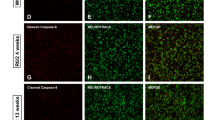Abstract
Huntington disease (HD) inclusions are stained with anti-ubiquitin and anti-proteasome antibodies. This, together with proteasome activity studies on transfected cell, suggested that alterations in the ubiquitin-proteasome system (UPS) might contribute to HD pathogenesis. In a previous work we reported that in a conditional mouse model of Huntington’s disease (HD94 mice), the chymiotrypsin- and trypsin-“like” activities of the proteasome are increased selectively in the affected and aggregate-containing brain regions: striatum and cortex. Moreover, in these areas a neuronal increase in the interferon-inducible subunits of the immunoproteasome LMP2 and LPM7 was observed. In order to test if the expression ofN-terminal mutant huntingtin (htt) by itself is sufficient to induce the change in proteasome catalytic activities as well as in LMP2 subunit expression, we performed enzymatic assays for the three different peptidase activities of the proteasome and western blot experiments in striatal cultured neurons from HD94 mice free of glial contamination. We found no changes in any of the activities in these cells. Furthermore, western blot analysis performed with specific antibody against LMP2 subunits, revealed no difference in levels of this subunit in striatal neurons from HD94 compared to control cultures. On the other hand, when the striatal cultures were treated with interferon-γ (IFN-γ) during 72 hours, a clear increase in LMP2 levels was observed in control neuronal cultures. Interestingly, this increase was much more pronounced (95% higher) in HD94 striatal cultures. These results indicate that although expression of mutant htt is not sufficient to induce the changes in proteasome catalytic core observed in HD, it synergizes the changes induced by IFN-γ. Furthermore, immunocytochemical studies revealed that HD94 striatal neurons expressing high levels of LMP2 subunit showed a pre-apoptotic appearance. These results suggest that the correlation between neuronal induction of the inmuno-proteasome and neurodegeneration found in HD brains is secondary to inflammatory processes.
Similar content being viewed by others
References
Ambrose CM, MP Duyao, G Barnes, GP Bates, CS Lin, J Srinidhi, S Baxendale, H Hummerich, H Lehrach, M Altherret al. (1994) Structure and expression of the Huntington’s disease gene: evidence against simple inactivation due to an expanded CAG repeat.Somat. Cell Mol. Genet. 20, 27–38.
Bence NF, RM Sampat and RR Kopito (2001) Impairment of the ubiquitin-proteasome system by protein aggregation.Science 292, 1552–1555.
Chai Y, SL Koppenhafer, SJ Shoesmith, MK Perez and HL Paulson (1999) Evidence for proteasome involvement in polyglutamine disease: localization to nuclear inclusions in SCA3/MJD and suppression of polyglutamine aggregationin vitro.Hum. Mol. Genet. 8, 673–682.
Cummings CJ, MA Mancini, B Antalffy, DB DeFranco, HT Orr and HY Zoghbi (1998) Chaperone suppression of aggregation and altered subcellular proteasome localization imply protein mis-folding in SCA1.Nat. Genet. 19, 148–154.
Davies SW, M Turmaine, BA Cozens, M DiFiglia, AH Sharp, CA Ross, E Scherzinger, EE Wanker, L Mangiarini and GP Bates (1997) Formation of neuronal intranuclear inclusions underlies the neurological dysfunction in mice transgenic for the HD mutation.Cell 90, 537–548.
Díaz-Hernández M, F Hernández, E Martín-Aparicio, P Gómez-Ramos, MA Morán, JG Castaño, I Ferrer, J Avila and JJ Lucas (2003) Neuronal induction of the inmunoproteasome in Huntington′s disease.J. Neurosci. 23, 11653–11661.
DiFiglia M, E Sapp, K Chase, S Davies, G Bates, J Vonsattel and N Aronin (1997) Aggregation of huntingtin in neuronal intranuclear inclusions and dystrophic neurites in brain.Science 277, 1990–1993.
Dubinsky JM (1989) Development of inhibitory synapses among striatal neuronsin vitro.J. Neurosci. 9, 3955–3965.
HDCRG (1993) A novel gene containing a trinucleotide repeat that is expanded and unstable on Huntington’s disease chromosomes.Cell 72, 971–983.
Hernández F, M Díaz-Hernández, J Avila and JJ Lucas (2004) Testing the ubiquitin-proteasome hypothesis of neurodegenera-tionin vivo.Trends Neurosci. 27, 66–69.
Huettner JE and RW Baughman (1986) Primary culture of identified neurons from the visual cortex of postnatal rats.J. Neurosci. 6, 3044–3060.
Jana NR, EA Zemskov, G Wang and N Nukina (2001) Altered pro-teasomal function due to the expression of polyglutamine-expanded truncatedN-terminal huntingtin induces apoptosis by caspase activation through mitochondrial cytochrome c release.Hum. Mol. Genet. 10, 1049–1059.
Kloetzel PM (2001) Antigen processing by the proteasome.Nat. Rev. Mol. Cell Biol. 2, 179–187.
Martin-Aparicio E, A Yamamoto, F Hernandez, R Hen, J Avila and JJ Lucas (2001) Proteasomal-dependent aggregate reversal and absence of cell death in a conditional mouse model of Huntington’s disease.J. Neurosci. 21, 8772–8781.
Nakamura K, SY Jeong, T Uchihara, M Anno, K Nagashima, T Nagashima, S Ikeda, S Tsuji and I Kanazawa (2001) SCA17, a novel autosomal dominant cerebellar ataxia caused by an expanded polyglutamine in TATA-binding protein.Hum. Mol. Genet. 10, 1441–1448.
Rock KL, IA York, T Saric and AL Goldberg (2002) Protein degradation and the generation of MHC class I-presented peptides.Adv. Immunol. 80, 1–70.
Ross CA (1997) Intranuclear neuronal inclusion: a common pathogenic mechamism for glutamine-repeat meurodegenerative diseases?Neuron 19, 1147–1150.
Stenoien DL, CJ Cummings, HP Adams, MG Mancini, K Patel, GN DeMartino, M Marcelli, NL Weigel and MA Mancini (1999) Polyglutamine-expanded androgen receptors form aggregates that sequester heat shock proteins, proteasome components and SRC-1, and are suppressed by the HDJ-2 chaperone.Hum. Mol. Genet. 8, 731–741.
Tanaka K and M Kasahara (1998) The MHC class I ligand-gener-ating system: roles of immunoproteasomes and the interferon-?-inducible proteasome activator PA28.Immunol. Rev. 163, 161–176.
Vallano ML (1990) Developmental regulation of type II calcium/calmodulin-dependent kinase isoforms in rat cerebellum.J. Neurobiol. 21, 1262–1273.
Yamamoto A, JJ Lucas and R Hen (2000) Reversal of neuropathol-ogy and motor dysfunction in a conditional model of Huntington’s disease.Cell 101, 57–66.
Author information
Authors and Affiliations
Corresponding author
Rights and permissions
About this article
Cite this article
Díaz-Hernández, M., Martín-Aparicio, E., Avila, J. et al. Enhaced induction of the immunoproteasome by interferon gamma in neurons expressing mutant huntingtin. neurotox res 6, 463–468 (2004). https://doi.org/10.1007/BF03033282
Received:
Revised:
Issue Date:
DOI: https://doi.org/10.1007/BF03033282




